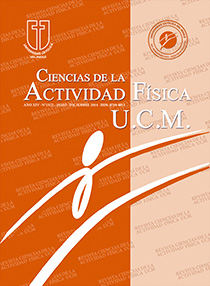Achten, J. & Jeukendrup, E. (2003). Heart rate monitoring applications and limitations. Sports Medicine, 33(7), 517-538. Disponible en http://web.ebscohost.com
Aránguiz, H., García, V., Rojas, S., Salas, C., Martínez, R. y Mac Millan, N. (2010). Estudio descriptivo, comparativo y correlacional del estado nutricional y condición cardiorrespiratoria en estudiantes universitarios de Chile. Revista Chilena de Nutrición, 37(1), 70-78. Disponible en http://www.scielo.cl/scielo.php?pid=S071775182010000100007&script=sci_arttext
Arena, R., Arrowood, J., Fei, D., Shelar, S., Helm, S. & Kraft, K. (2010). The influence of sex on the relationship between heart rate recovery and other cardiovascular risk factors in apparently healthy subjects. Scandinavian Journal of Medicine & Science in Sport, 20, 291-297. doi:10.1111/j.1600- 0838.2009.00883.x
Bahamonde, P. (2012). Informe evaluación física a carabineros de Chile evaluación de la capacidad aeróbica sub-máxima. Educación Física Chile, 270, 43-52. Disponible en http://www.umce.cl/recursos-y-servicios/servicios/centro-dedescargas/doc_download/1892-revista-efisica-umce-2012.html
Barak, O., Jakovljevic, D., Popadic, J., Ovcin, Z., Brodie, D. & Grujic, N. (2010). Heart rate variability before and after cycle exercise in relation to different body positions. Journal of Sport Science and Medicine, 9, 176-182. Disponible en http://web.ebscohost.com
Barstow, T., Buchthal, S., Zanconato, S. & Cooper, D. (1994). Muscle energetics and pulmonary oxygen uptake kinetics during moderate exercise [abstract]. Journal of Applied Physiology, 77(4), 1742-1749. Disponible en http://web.ebscohost.com
Borresen, J. & Lambert, M. (2008). Autonomic control of heart rate during and after exercise. Sport Med, 38(8), 633-646. Disponible en http://web.ebscohost.com
Buono, M., Roby, J., Micale, F., Sallis, J. & Shepard, E. (1991). Validity and reliability of predicting maximun oxygen uptake via field test in children and adolescents. Pediatric Exercise Science, 3, 250-255. Disponible en http://web.ebscohost.com
Chatterjee, S., Chatterjee, P., Mukherjee, P. & Bandyopadhyay, A. (2004). Validity of Queen's College step test for use with young indian men. British Journal Sports Medicine. doi: 10.1136/ bjsm.2002.002212
Chatterjee, S., Chatterjee, P. & Bandyopadhyay, A. (2005). Validity of Queen’s College Step Test for estimation of maximum oxygen uptake in female students. Indian Journal of Medicical Research. doi:10.1136/bjsm.2002.002212
Darby, L. & Marsh, J. (2007). Specifity of a maximal step exercise test. Measurement in Physical Education and Exercise Science, 11(3), 131–148. Disponible en http://web.ebscohost.com
Das, B., Ghosh, T. & Gangopadhyay, S. (2010). A corrparative study of physical fitness index (PFI) and predicted maximum aerobic capacity (VO₂ max.) among the different groups of female students in west bengal, india. International Journal of Applied Sport Sciences, 20(1), 13-23. Disponible en http://web.ebscohost.com
Hughson, R. (1990). Exploring cardiorespiratory control mechanisms through gas exchange dynamics [abstract]. Medicine and Science in Sports and Exercise, 22(1), 72-79. Disponible en http://web.ebscohost.com
Javorka, M., Zila, Y., Balhárek, T. & Javorka, K. (2002). Heart rate recovery after exercise: relations to heart rate variability and complexity [abstract]. Brazilian Journal of Medical and Biological Research, 35(8), 991-1000. Disponible en http://web.ebscohost.com
Karjalainen, P. (2012). Heart rate recovery after maximal and submaximal exercise. (Tesis de maestría). University of Jyväskylä, Finlandia. Disponible en https://jyx.jyu.fi/dspace/handle/123456789/40063
Keytel, L., Goedecke, J., Noakes, T., Hiiloskorpi, H., Laukkanen, R., Van der Merwe, L. & Lambert, V. (2005). Prediction of energy expenditure from heart rate monitoring during submaximal exercise. Journal of Sport Sciences, 23(3), 289-297. doi:10.1080/02640410 470001730089
Lamberts, R., Lemmink, K., Durandt, J., & Lambert, M. (2004). Variation in heart rate during submaximal exercise: implications for monitoring training. Journal of Strength and Conditioning Research, 18(3), 641-645. Disponible en http://web.ebscohost.com
Lamberts, R., Swart, J., Noakes, T. & Lambert, M. (2009). Changes in heart rate recovery after high-intensity training in well-trained cyclists. European Journal of Applied Physiology, 105, 705- 713. doi:10.1007/s00421-008-0952-y
Léger, L. & Lambert, J. (1982). A maximal multistage 20-m shuttle run test to predict VO2 máx. European Journal of Applied Physiology, 49, 1-12.
Londeree, B. & Ames, S. (1976). Trend analysis of the % VO2 max-HR regression [abstract]. Medicine and Sciences in Sports, 8(2), 123-125. Disponible en http://web.ebscohost.com
López, J. y Fernández, A. (2008). Fisiología del ejercicio (3a ed.). Madrid: Médica Panamericana.
Lubans, D., Morgan, P., Collins, C., Boreham, C. & Callister, R. (2009). The relationship between heart rate intensity and pedometer step counts in adolescents. Journal Sport Sciences, 27(6), 591-597. doi:10.1080/02640410802676687
McArdle, W., Katch, F. y Katch, V. (1990). Fisiología del ejercicio: energía, nutrición y rendimiento humano (2a ed.). Madrid, España: Alianza Deporte.
Midgley, A., Carroll, S., Marchant, D., McNaughton, L. & Siegler, J. (2009). Evaluation of true maximal oxygen uptake based on a novel set standardized criteria. Applied Physiology, Nutrition and Metabolism, 34, 115-123. doi:10.1139/H08-146
Robergs, R. & Landwehr, R. (2002). The surprising history of the "HRmax=220- age" equation. Official Journal of The American Society of Exercise Physiologists, 5(2), 1-10. Disponible en http://web.ebscohost.com
Souza, M., Lima, A., Silva, J., Silva, G., Pontes, L. & Lira, F. (2007). Cardiac frequency and blood pressure in different loads in the cirilo's ergometer step in the active women. Fitness Preformance, 6(3), 156- 161. doi:10.3900/fpj.6.3.156.e
Tanaka, H., Monahan, K. & Seals, D. (2001) Age – predicted maximal heart rate revisited. Journal of the American College of Cardiology, 37(1), 153-156. doi: 10.1016/S0735-1097(00)01054-8
Whipp, B. (1994). The slow component of O2 uptake kinetics during heavy exercise [abstract]. Medicine and Science in Sports and Exercise, 26(11), 1319-1326. Disponible en http://web.ebscohost.com, www.agenciaeducación.cl y www.csep.ca
Xu, F. & Rhodes, E. (1999). Oxyegn uptake kinetics during exercise. Sport Meds, 27(5), 313-327. Disponible en http://web.ebscohost.com


